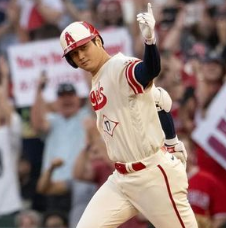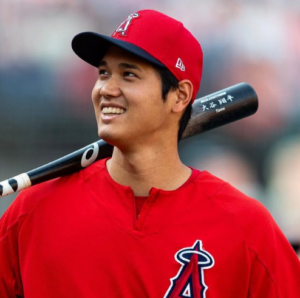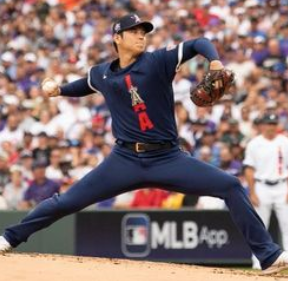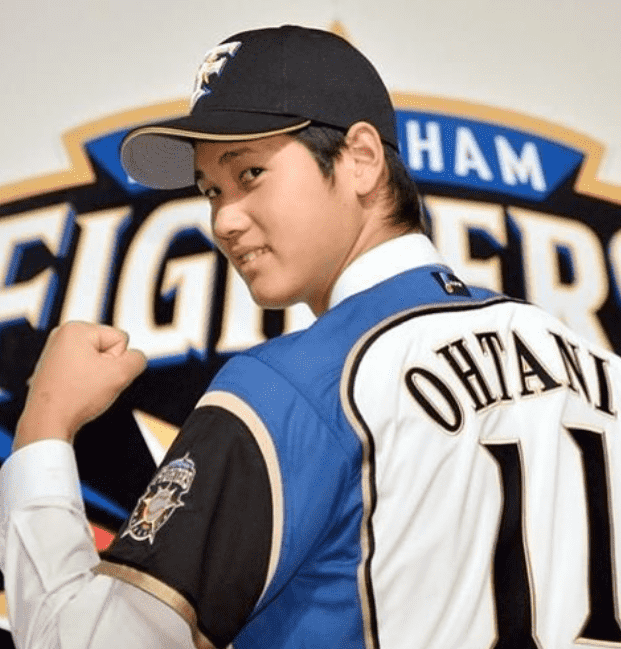In a groundbreaking move, Shohei Ohtani has inked a monumental 10-year contract with the Los Angeles Dodgers, catapulting him into the annals of sports history
This deal not only smashes records in Major League Baseball (MLB) but also establishes itself as the most substantial contract ever witnessed in North American sports, surpassing even the remarkable 10-year, $503 million pact of Chiefs’ quarterback Patrick Mahomes.
Ohtani’s contract also eclipses the previous benchmark set by his former teammate, Mike Trout, with a staggering 12-year, $426.5 million agreement, securing its place as the largest fully guaranteed deal in North American sports history.
Shohei Ohtani not only cements his position as a baseball icon but also leaves an indelible mark on the business side of the sport.
The implications of this groundbreaking deal extend far beyond the playing field, signaling a new era in player compensation strategies and financial maneuvering within the realm of professional sports.
As the Dodgers embark on this transformative journey with Ohtani, the legacy of this unprecedented contract is poised to shape the future landscape of sports contracts and financial negotiations in North America.

Also Read: What is Jordan Rainer Age? Bio, Parents And Siblings Explored
Table of Contents
Shohei Ohtani: New Contract
The Financial Landscape: Ohtani’s Multi-Million Dollar Averaging
This historic contract breaks down to an impressive average annual value (AAV) of $70 million per year, significantly outpacing the joint second position held by Justin Verlander and Max Scherzer, each with an AAV of $43.3 million.1
However, delving deeper into the intricacies of the deal, The Athletic’s Ken Rosenthal brings to light the presence of “unprecedented deferrals” that influence the calculus of Ohtani’s average salary.
Despite the headline figure of $70 million annually, these deferrals ingeniously manipulate the immediate financial impact on the Dodgers.
As a result, the organization will extend payments to Ohtani well beyond the contract’s conclusion in 2033. The exact duration of these deferrals remains undisclosed, adding an element of intrigue to this already extraordinary deal.
Navigating the Financial Landscape: Ohtani’s Impact on Dodgers’ Long-Term Fiscal Strategy
While Ohtani’s contract undeniably sets a new standard for player compensation, the strategic inclusion of deferrals provides the Dodgers with a unique financial advantage.
By spreading the financial commitment over an extended period, the team can better manage its payroll structure and navigate the evolving landscape of professional sports economics.

Shohei Ohtani: Age
A Deep Dive into the Baseball Prodigy’s Timeline
Inking the contract with the Dodgers, Shohei Ohtani, the baseball sensation, stands at the crossroads of age and achievement.
Let’s unravel the chronological tapestry of this phenomenal athlete, exploring key milestones and projecting into the future.
At the moment of penning his signature on the dotted line for the Dodgers, Shohei Ohtani is a seasoned 29-year-old. This pivotal juncture in his career marks not only a contractual commitment but also a reflection of the experience and prowess he brings to the field.
Peering into the Future: The Contract Duration
The ink may have just dried on the contract, but projections extend our glimpse into Shohei Ohtani’s future. The deal he’s bound by is set to run its course until 2033.
Fast forward to that expiration date, and Ohtani will have gracefully aged to 39, bringing forth a seasoned veteran’s perspective to the game.
As we delve into the intricacies of Ohtani’s age, it’s essential to acknowledge the dynamic relationship between age and athletic performance.
With a trajectory spanning from his current 29-year-old self to the anticipated 39-year-old version in 2033, Ohtani’s career is a canvas upon which the brushstrokes of experience and adaptability will be vividly painted.
Crafting a Legacy: Ohtani’s Journey Beyond the Numbers
Beyond the numerical representation of age lies Shohei Ohtani’s indomitable spirit and commitment to the sport. Each passing year adds layers to the narrative, with every season etching a chapter in the legacy of this baseball prodigy.
Age often becomes a quantitative benchmark. However, in the case of Shohei Ohtani, it is a qualitative testament to brilliance.
As the sands of time trickle down, the baseball world eagerly watches the evolution of this extraordinary athlete, anticipating the chapters of greatness that age will inevitably script in his awe-inspiring journey.

Also Read: Kaitlyn and Kenzie: Christine Sinclair’s Nieces, Bio, Career, Height, Weight, Promotion and More
Shohei Ohtani: Bio
Childhood Chronicles
Shohei Ohtani, the phenom from Ōshū, Iwate, Japan, embarked on his extraordinary baseball journey on July 5, 1994.
As the youngest among three siblings, his early exposure to the sport was courtesy of his father, Toru, a former corporate league baseball player and dedicated Mitsubishi plant employee.
Toru’s encouragement resonated within the Ohtani household, motivating both Shohei and his elder brother Ryuta to embrace the game.
By the tender age of eight, Ohtani showcased immense promise, securing a regular spot in a weekend little league. Meanwhile, his mother, a high school badminton champion, added an athletic flair to the family dynamic.
Early Inspirations
In the formative years, Ohtani found inspiration in the prowess of power-hitting left fielder Hideki Matsui, renowned for his time with Tokyo’s Yomiuri Giants—the sole team young Ohtani avidly followed on television.
Intrigued by both batting and pitching, he initially regarded baseball as a mere pastime.
Hanamaki Higashi High School became the crucible where Ohtani’s capabilities drew the spotlight.
A mere 16-year-old, he was already hurling pitches in the mid-90s. Remarkably, within a year, his velocity soared to an impressive 99 mph.
Possessing a towering height of six-foot-five at 17, he transformed into a dynamic player. However, this rapid growth came with its share of challenges, as persistent groin and hamstring injuries plagued his high school tenure.
Shohei’s dog should be named MVP ???? pic.twitter.com/LmG9knlTU0
— 大谷翔平 ¹⁷ Ohtani Shohei ¹⁷ ???? (@shoheisaveus) November 17, 2023
Overcoming Adversities
Amidst this period, Ohtani grappled with pitching mechanics that hindered his accuracy. His delivery became strained and rigid, causing him to struggle with keeping the ball in the strike zone.
Yet, as he gradually grew into his imposing physique, these challenges diminished, paving the way for his ascendancy.
Shohei Ohtani’s journey from a baseball-loving child to a high school prodigy lays the groundwork for the exceptional career that awaits him.
Stay tuned for the next chapter in Ohtani’s saga as we explore his collegiate endeavors and the transition to professional baseball stardom.

Shohei Ohtani: Career
From Japan to MLB Stardom
In the nascent phase of his illustrious career, Shohei Ohtani made headlines by clinching the title of the fastest pitch ever recorded by a Japanese high school pitcher, reaching an impressive 99 mph.
His prowess extended to the global stage when he participated in the 2012 18U Baseball World Championship, finishing with a record of 0-1 but boasting 16 strikeouts in just 10 1⁄3 innings pitched.
Ohtani’s decision to transition to the US major leagues after high school attracted interest from baseball powerhouses such as the Texas Rangers, Boston Red Sox, New York Yankees, and Los Angeles Dodgers.
Despite the allure of international fame, the Nippon-Ham Fighters, led by general manager Masao Yamada, took a bold stance by selecting him as their first draft pick.
A Tug of War: Japan vs. MLB
Announcing his intention to move to the US on October 21, 2012, Ohtani faced a persuasive campaign from the Nippon-Ham Fighters.
They highlighted the benefits of avoiding the grind of US minor leagues, emphasizing the potential for lucrative endorsement deals and national hero status in Japan.
After careful deliberation, Ohtani accepted the Fighters’ offer. He made his debut as a rightfielder on March 29, 2013, and enjoyed a stellar first year in MPB with a 3-0 record in 11 starts.
Wearing the legendary Yu Darvish’s former jersey number (11), Ohtani showcased his versatility as both an outfielder and pitcher.
His outstanding performance earned him a spot in the Pacific League roster for the 2013 All-Star Game, setting the stage for a remarkable career.

Dual Threat: Outfielder and Pitcher
- Over the next two seasons, Ohtani solidified his role as a pivotal player for the Nippon-Ham Fighters.
- Juggling responsibilities as both an outfielder and pitcher, he continued to enhance his batting skills.
- He secured All-Star Game appearances in these seasons, and by the end of 2014, his annual salary reached an impressive 100 million yen.
- The 2016 season marked a pinnacle in Ohtani’s career. Excelling as both a batter and a dominant pitcher, he played a crucial role in the Fighters winning the 2016 Japan Series.
- His outstanding performance earned him the MVP award, with an overwhelming 253 out of 254 first-place votes.
- In 2017, Ohtani’s stellar performance continued, showcasing a hitting average of .332 with eight home runs and 31 RBIs.
- His ambition to join the MLB for the 2018 season was briefly halted by an ankle injury, requiring surgery and limiting his playtime.
- On December 8, 2017, Ohtani officially became part of the Los Angeles Angels roster, finalizing a contract that would set the stage for his remarkable journey in Major League Baseball.
View this post on Instagram
FAQ’s
1. What position does Shohei Ohtani play in baseball?
Shohei Ohtani is a versatile player who excels both as a pitcher and a designated hitter. In Major League Baseball (MLB), he plays for the Los Angeles Angels.
As a pitcher, he showcases his skills on the mound, while as a designated hitter, he contributes to the team’s offense.
2. Is Shohei Ohtani the only player who pitches and hits in MLB?
While Shohei Ohtani is a rare talent known for his exceptional abilities as both a pitcher and hitter, he is not the only player to have done so in MLB history.
However, Ohtani’s proficiency in both roles has garnered significant attention, making him a standout figure in contemporary baseball.
3. What records has Shohei Ohtani set in MLB?
Shohei Ohtani has achieved several remarkable milestones in MLB. Notably, he became the first player in modern baseball history to be selected as an All-Star as both a pitcher and a hitter.
Ohtani’s accomplishments include setting records for home runs and pitching strikeouts, showcasing his unprecedented impact on the game.
4. Where is Shohei Ohtani from, and how did he enter MLB?
Shohei Ohtani hails from Japan. He began his professional baseball career with the Hokkaido Nippon-Ham Fighters in the Nippon Professional Baseball (NPB) league.
In 2017, Ohtani made the transition to MLB, signing with the Los Angeles Angels. His arrival in the major leagues generated immense anticipation, and he has since become a global baseball sensation.
5. How has Shohei Ohtani’s dual role impacted the Los Angeles Angels?
Shohei Ohtani’s dual role as a pitcher and designated hitter has had a transformative impact on the Los Angeles Angels. His exceptional performance on the mound and at the plate has elevated the team’s competitiveness.
Ohtani’s unique skill set brings a dynamic element to the Angels’ game strategy and has made him a pivotal player in the team’s pursuit of success in MLB.
Also Read: Meet Valentina Shevchenko and Antonia Shevchenko, Career, Bio, Caribbean and More




